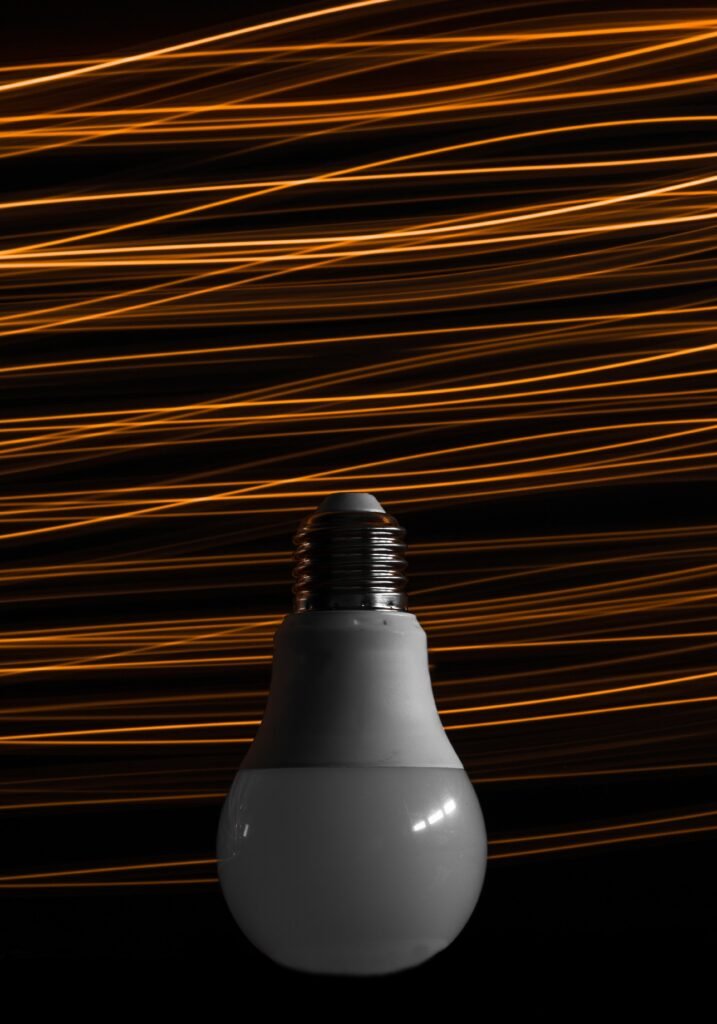Are you tired of dull and dim lighting in your home or office? Look no further. In this article, you will discover how to bring a vibrant and well-lit ambiance to your space with energy-efficient lighting solutions. Say goodbye to high energy bills and hello to a brighter, more eco-friendly environment. Whether you are looking to upgrade your current lighting fixtures or completely revamp your space, these innovative solutions will not only enhance the aesthetics but also save you money in the long run. Get ready to brighten up your world with the power of energy-efficient lighting!
Benefits of Energy-Efficient Lighting
Reduced Energy Consumption
Energy-efficient lighting is designed to consume less energy compared to traditional lighting options. By using energy-efficient bulbs, you can significantly reduce your energy consumption, which not only helps to conserve natural resources but also reduces greenhouse gas emissions. You can contribute to a greener environment simply by making the switch to energy-efficient lighting.
Lower Energy Bills
One of the immediate benefits of energy-efficient lighting is the reduction in energy bills. Energy-efficient bulbs use less electricity to produce the same amount of light as traditional bulbs, resulting in lower energy costs. Over time, these savings can add up, providing you with extra money to spend on other things or put into savings.
Longer Lifespan
Energy-efficient bulbs, such as LED and CFL lights, have a significantly longer lifespan compared to traditional incandescent bulbs. LED bulbs, in particular, can last up to 25 times longer. This means you won’t have to change bulbs as frequently, saving you time and money on replacements.
Enhanced Durability
Energy-efficient bulbs are built to withstand vibrations, shocks, and other external factors. This makes them more durable and longer-lasting than traditional bulbs, which are generally more fragile. With energy-efficient lighting, you can enjoy reliable performance without the worry of bulbs breaking easily.
Types of Energy-Efficient Lighting
LED Lighting
LED (Light Emitting Diode) lighting has gained widespread popularity due to its many advantages. LED bulbs are extremely energy-efficient, using up to 80% less energy than incandescent bulbs. They also have a long lifespan, low heat emission, and are available in a variety of colors and styles.
CFL Lighting
Compact Fluorescent Lamp (CFL) lighting is another popular choice for energy-efficient lighting. CFL bulbs use about 75% less energy than incandescent bulbs and can last up to ten times longer. They provide a warm, soft light and are available in various shapes and sizes to fit different fixtures.
Halogen Lighting
Halogen lighting is a type of incandescent lighting that is more energy-efficient than traditional incandescent bulbs. They offer excellent color rendering and a bright, crisp light. While halogen bulbs are not as energy-efficient as LED or CFL bulbs, they still offer notable energy savings compared to traditional incandescent bulbs.

LED Lighting
Introduction to LED Lighting
LED lighting is a revolutionary technology that uses semiconductors to produce light. Unlike traditional bulbs that rely on heating a filament, LED bulbs create light through an electrical current passing through a microchip. This process is highly efficient, resulting in less wasted energy and lower operating costs.
Advantages of LED Lighting
LED lighting offers numerous advantages, making it a popular choice for both residential and commercial applications. LED bulbs have a significantly longer lifespan, reducing the frequency of bulb replacements. They are extremely energy-efficient, consuming less electricity while providing the same level of brightness. LED bulbs also emit less heat, making them safer to touch and reducing the load on cooling systems. Additionally, LED lighting is available in various colors and can be dimmed to create different moods and ambiances.
Disadvantages of LED Lighting
While LED lighting has several advantages, it also has a few drawbacks to consider. The upfront cost of LED bulbs is generally higher compared to traditional bulbs, although the price has come down in recent years. Some LED bulbs may have a narrow beam angle, which can result in more focused lighting and less spread. It’s also important to note that LED bulbs may contain small amounts of potentially harmful substances, such as lead and mercury, although proper disposal methods eliminate any environmental risks.
CFL Lighting
Introduction to CFL Lighting
CFL lighting utilizes a fluorescent tube that is twisted or folded to fit into a compact shape. These bulbs work by passing an electric current through a gas-filled tube, which then produces ultraviolet light. This light is absorbed and re-emitted by a phosphor coating inside the bulb, creating visible light.
Advantages of CFL Lighting
CFL lighting offers several advantages that make it a popular choice for energy-efficient solutions. CFL bulbs are highly energy-efficient, using about 75% less energy compared to traditional incandescent bulbs. They also have a longer lifespan, saving you money on replacements. Additionally, CFL bulbs emit less heat, making them safer to handle and reducing the cooling load in your space. CFL lighting is available in various colors and shapes, allowing you to find the perfect fit for your needs.
Disadvantages of CFL Lighting
Despite its many advantages, CFL lighting does have a few drawbacks. CFL bulbs take a short time to warm up and reach full brightness when initially turned on. This can be a minor inconvenience in spaces where immediate, bright lighting is required. CFL bulbs also contain small amounts of mercury, which means they require special disposal methods to prevent environmental contamination. It’s essential to handle and dispose of CFL bulbs properly to minimize any potential hazards.

Halogen Lighting
Introduction to Halogen Lighting
Halogen lighting is a type of incandescent lighting that uses halogen gas to enhance its performance. These bulbs produce bright, white light and have excellent color rendering properties, making them ideal for spaces where accurate color perception is essential. Halogen bulbs are available in various sizes and styles, making them suitable for a wide range of applications.
Advantages of Halogen Lighting
Halogen lighting offers several advantages, making it a popular choice for both residential and commercial use. Halogen bulbs provide instant brightness without any warm-up time, making them ideal for spaces where immediate full lighting is required. They also have a long lifespan compared to traditional incandescent bulbs, reducing the frequency of replacements. Halogen bulbs are fully dimmable, allowing you to vary the brightness according to your needs and create different atmospheres.
Disadvantages of Halogen Lighting
While halogen lighting has its advantages, it also has a few drawbacks to consider. Halogen bulbs are less energy-efficient compared to LED or CFL bulbs, which means they consume more electricity and result in higher energy costs. They also emit more heat, which can increase the cooling load and potentially be a safety concern. Additionally, halogen bulbs are more fragile and sensitive to touch, requiring cautious handling and installation.
Choosing the Right Energy-Efficient Lighting
Consider the Brightness
When choosing energy-efficient lighting, consider the brightness level you need for the specific space. Different bulbs have different lumen outputs, which measure the amount of visible light they produce. Determine the desired brightness level and select bulbs accordingly to ensure optimal illumination.
Consider the Color Temperature
Color temperature refers to the color appearance of the light emitted by a bulb. It is measured in Kelvin (K) and can range from warm white (lower Kelvin values) to cool white (higher Kelvin values). Consider the atmosphere you want to create in each space and choose bulbs with appropriate color temperatures to achieve the desired effect.
Consider the Energy Efficiency Rating
Energy-efficient bulbs are labeled with an energy efficiency rating, typically displayed as an Energy Star rating. This rating indicates how efficient the bulb is in terms of lumens per watt. Look for bulbs with higher energy efficiency ratings to maximize energy savings and minimize environmental impact.
Consider the Lifespan
Pay attention to the lifespan of different energy-efficient bulbs. LED bulbs generally have the longest lifespan, followed by CFL bulbs and then halogen bulbs. A longer lifespan means fewer replacements, saving you money and reducing waste.

Energy-Efficient Lighting for Different Spaces
Living Room
In the living room, you may want a combination of ambient lighting and task lighting. LED recessed lights or track lighting can provide general illumination, while LED floor or table lamps can offer focused lighting for reading or other activities.
Kitchen
The kitchen requires bright and efficient lighting for cooking and food preparation. LED under cabinet lights can provide task lighting, while LED recessed lights or pendant lights are ideal for overall illumination. Consider LED strip lights for accent lighting to highlight specific areas or features.
Bedroom
In the bedroom, it’s important to create a relaxing and cozy atmosphere. LED dimmable ceiling lights or wall sconces can provide adjustable ambient lighting, while LED bedside lamps can offer convenient task lighting for reading. Consider warm white bulbs with lower color temperature for a soothing environment.
Bathroom
The bathroom requires good lighting for grooming and hygiene tasks. LED vanity lights or sconces can provide bright and even lighting around the mirror, while LED recessed lights or flush ceiling lights can offer general illumination. Make sure the chosen bulbs have a high color rendering index (CRI) for accurate color representation.
Installation and Maintenance of Energy-Efficient Lighting
Replacing Existing Light Fixtures
To install energy-efficient lighting, start by replacing existing light fixtures. Follow the manufacturer’s instructions and take necessary safety precautions. Make sure to turn off the power before replacing any bulbs or fixtures. Consult a professional electrician for complex installations or if you are unsure about the process.
Proper Maintenance Techniques
To ensure optimal performance and longevity of energy-efficient bulbs, proper maintenance is essential. Keep the light fixtures clean and dust-free to maximize brightness output. If any bulbs start to flicker or dim, replace them promptly to prevent further issues. Regularly check for loose connections or damaged wiring and address any problems immediately.
Disposal of Old Lighting
It’s important to dispose of old lighting properly to minimize environmental impact. Some energy-efficient bulbs, such as CFL bulbs, contain small amounts of mercury and should not be disposed of in regular waste. Contact your local recycling or hazardous waste facility to learn the proper procedures for recycling or disposing of old lighting.

Additional Energy-Saving Tips
Use Natural Lighting
Take advantage of natural light whenever possible. Open curtains or blinds during the day to let in sunlight and reduce the need for artificial lighting. Position furniture and decor strategically to maximize natural light penetration throughout the space.
Install Dimmer Switches
Installing dimmer switches allows you to adjust the brightness of your light fixtures according to your needs. Dimming the lights can help save energy and create different atmospheres for various activities or times of the day.
Turn Off Lights When Not in Use
A simple yet effective energy-saving tip is to turn off lights when you leave a room or when they are not needed. Make it a habit to develop energy-conscious practices and encourage others in your household to do the same. This small change can make a significant impact over time.
Conclusion
Make the Switch to Energy-Efficient Lighting Today! By choosing energy-efficient lighting, you can enjoy numerous benefits, such as reduced energy consumption, lower energy bills, longer lifespan, and enhanced durability. LED, CFL, and halogen lighting are all viable options, each with its unique advantages and disadvantages. Consider factors such as brightness, color temperature, energy efficiency rating, and lifespan when selecting the right bulbs for your space. Make sure to install and maintain your energy-efficient lighting properly to maximize performance and longevity. Don’t forget to implement additional energy-saving tips, such as utilizing natural lighting, installing dimmer switches, and turning off lights when not in use. By embracing energy-efficient lighting solutions, you can save money, reduce your environmental impact, and enjoy a well-lit and sustainable space. So, brighten up your space with energy-efficient lighting today and make a positive change!



